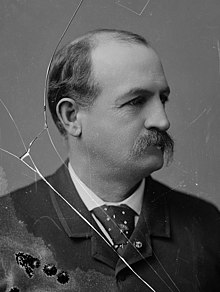Lewis Wolfley
Lewis Wolfley | |
|---|---|
 | |
| 8th Governor of Arizona Territory | |
| In office April 8, 1889 – August 20, 1890 | |
| Nominated by | Benjamin Harrison |
| Preceded by | C. Meyer Zulick |
| Succeeded by | John N. Irwin |
| Personal details | |
| Born | October 8, 1839 Los Angeles, California, US |
| Political party | Republican |
| Profession | Civil engineer |
Lewis Wolfley (October 8, 1839 – February 12, 1910) was an American civil engineer who served as the eighth Governor of Arizona Territory. He is commonly regarded as the first territorial governor to be a resident of Arizona at the time of his appointment and was the only bachelor to hold the position.[A]
Wolfley's political career was marred by his almost complete lack of political skill.[2] Much of his time as governor was spent in political infighting, which eventually led to his resignation.
Background
Wolfley was born in Philadelphia, Pennsylvania, to Lewis and Elanor (Irwin) Wolfley. When he was a young child, his father died, and Wolfley grew up near the border of Ohio and Kentucky. His mother's family, the Ewings of Ohio, arranged for his education which included the study of civil engineering and possibly law. As a young man he worked for railroads operating in Iowa and Ohio.[1][3]
During the
Governorship
When
The first issue that Wolfley faced as Governor was dealing with appointment of territorial officers. Democratic Governor Zulick, as part of his normal duties, had submitted a full slate of nominations to the 15th Arizona Territorial Legislature. The Republican controlled legislature rejected Zulick's nominations and postponed adjournment after learning of Wolfley's nomination in order to allow the new governor to appoint his own candidates. Many of the Democratic nominees refused to surrender their offices, arguing that the territorial legislature had exceeded their authorized session limit of 60 days prior to confirmation of the Republican nominees and that the Governor could only make recess appointments following the death or resignation of a current office holder. As a result, Arizona Territory effectively had two sets of territorial officers with the Democratic office holders, due to their earlier appointment, controlling the buildings and records needed to perform various duties.[8]
The territorial government's ability to function was severely impacted by the two sets of territorial officials.[9] As an early step in resolving the issue, a lawsuit was filed to declare the Republican nominee for Territorial Treasurer the legitimate office holder. The court ruled in favor of the Republican nominee, but the details of the ruling left other Republican nominees reluctant to also file suit.[8] While the courts eventually ruled in favor of Wolfley's appointments, it was his administration's withholding of salary payments that eventually forced all the Democratic nominees to surrender their offices.[10]
Wolfley's problems with infighting also extended to members of his own party. William Christy, an unsuccessful candidate for the governorship, worked with a group of supporters to remove the Governor from office.
The primary accomplishment of the Wolfley administration was refinancing the territorial debt. The lower interest rate obtained by the refinancing reduced annual interest payments by US$59,006.40 per year.
By the end of 1889, most of the territory's newspapers were calling for Wolfley's removal.
After office
After his resignation, Wolfley moved to
Wolfey made another request to become governor in 1897, but was not nominated by President
Notes
References
Citations
- ^ a b c Wagoner 1970, p. 259.
- ^ Goff 1978, pp. 108–09.
- ^ a b Goff 1978, p. 109.
- ^ Goff 1978, pp. 109–10.
- ^ Goff 1978, p. 110.
- ^ Wagoner 1970, p. 257.
- ^ Goff 1978, p. 112.
- ^ a b Wagoner 1970, p. 260.
- ^ Wagoner 1970, p. 261.
- ^ Wagoner 1970, p. 263.
- ^ Goff 1978, p. 113.
- ^ Wagoner 1970, pp. 264–65.
- ^ Wagoner 1970, pp. 265–66.
- ^ Wagoner 1970, pp. 268–69.
- ^ a b Wagoner 1970, p. 275.
- ^ Wagoner 1970, p. 269.
- ^ Wagoner 1970, pp. 271–74.
- ^ Goff 1978, p. 114.
- ^ Wagoner 1970, p. 268.
- ^ Wagoner 1970, pp. 276, 278.
- ^ Goff 1978, p. 116.
- ^ a b Goff 1978, p. 117.
- ^ "Governor Wolfley Fatally Injured". Arizona Republic. Phoenix, Arizona. February 12, 1910. p. 5.
Sources
- Goff, John S. (1978). Arizona Territorial Officials Volume II: The Governors 1863–1912. Cave Creek, Arizona: Black Mountain Press. OCLC 5100411.
- Wagoner, Jay J. (1970). Arizona Territory 1863–1912: A Political history. Tucson: University of Arizona Press. ISBN 0-8165-0176-9.

